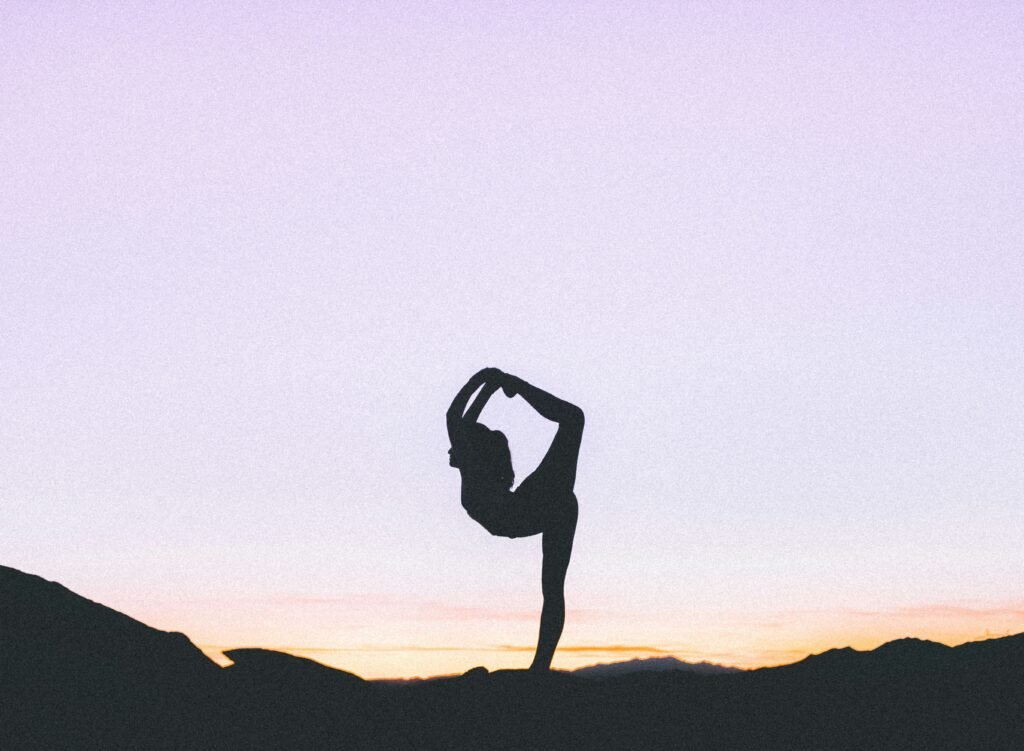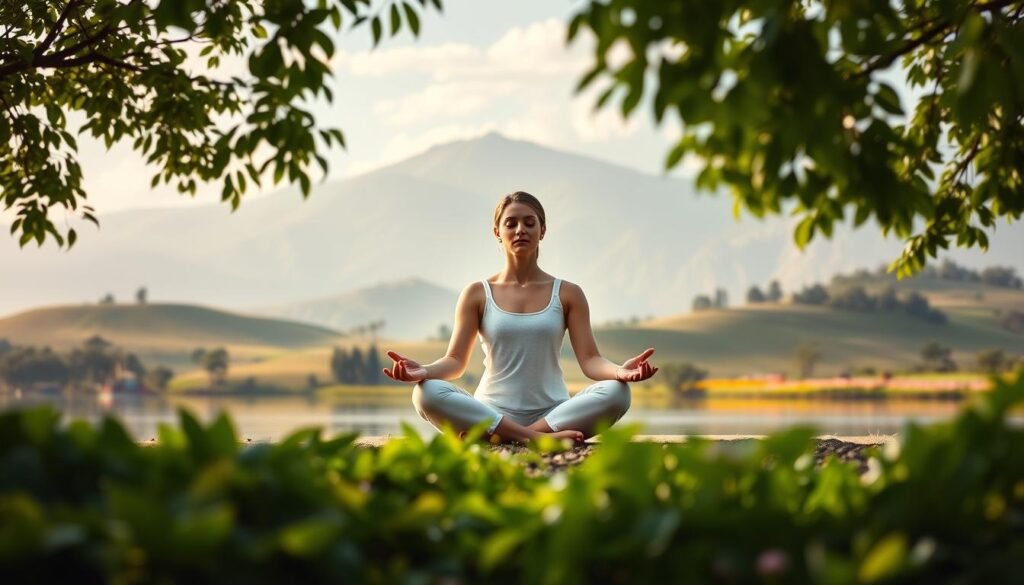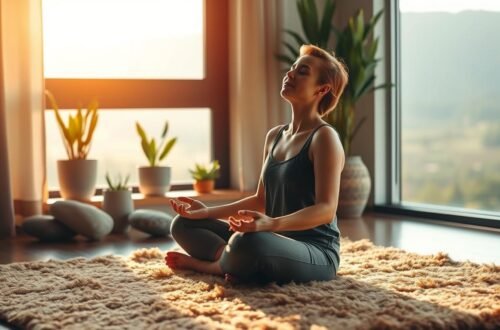Did you know nearly 1 in 5 adults in the United States faces mental illness each year? This fact shows how vital holistic well-being is in our lives. It’s key to balance your emotional, psychological, and social health for true wellness.
By focusing on mind and body wellness, you can find inner peace and vitality. Simple steps like meditation, exercise, and eating well can greatly boost your health. Adopting these habits can make your life more balanced and fulfilling.
Key Takeaways
- Prioritizing holistic well-being is essential for overall health.
- Simple practices like meditation and exercise can improve mental health.
- Achieving balance between emotional, psychological, and social health is crucial.
- Healthy habits can lead to a more balanced and fulfilling life.
- Embracing mind and body wellness can unlock inner peace and vitality.
The Science of Mind-Body Connection
Understanding how your mind and body work together is key to feeling whole. Research shows that your mental state affects your physical health. This connection is backed by many studies.
Mind-body connection is about how your thoughts, feelings, and health are linked. Studies find that being kind and active can make you feel better. It can boost your mood and self-esteem.
How Your Thoughts Affect Your Physical Health
Your thoughts and feelings can really impact your health. Stress can weaken your immune system, but positive thinking can make you feel better. Meditation and mindfulness can help reduce stress.

Research-Backed Benefits of Holistic Wellness
Practices that mix mental and physical health have many benefits. They can improve your mood, brain function, and overall health. By trying these holistic approaches, you can see these benefits for yourself and live a better life.
Assessing Your Current Mind and Body Well-Being
Understanding your mind and body well-being is key to a balanced life. Knowing your current state helps you make better health choices.
Recognizing Signs of Mental and Physical Imbalance
It’s important to spot signs of imbalance in your mind and body. Feeling tired, anxious, or having trouble focusing are signs you need to address. By noticing these signs, you can start working towards balance.
Practical Self-Assessment Tools and Techniques
Using practical tools can help you check your well-being. These tools help you find areas to improve. This way, you can make a plan to boost your mental and physical health.
Mental Health Check-In Questions
Ask yourself: How am I feeling today? What’s my stress level? Thinking about these questions can help you understand your mental state. It guides you in building daily habits for mind body balance.
Physical Wellness Evaluation Methods
Check your physical health by tracking sleep, food, and exercise. The NIH Wellness Toolkits and CDC resources have great tips for emotional and social health. They support your path to holistic wellness and mental and physical self-care routines.

Creating Your Personalized Holistic Wellness Plan
Starting a journey to holistic wellness means making a plan that fits you. It’s about changing your mind and body for better health. This way, you can feel your best.
Setting SMART Health Goals
First, set SMART health goals. This means making goals that are clear, measurable, and achievable. For example, “I will lose 5% body fat in 3 months by exercising 30 minutes, 3 times a week.” This keeps you focused and motivated.
Designing Daily, Weekly, and Monthly Practices
Creating a routine is key for a good wellness plan. Include morning meditation, weekly yoga, and monthly health checks. These habits help you feel better and balance your mind and body.
How to Track Progress and Make Adjustments
It’s important to track how you’re doing. Use a journal or app to log your activities, sleep, and feelings. Reviewing your progress helps you tweak your plan. This keeps you moving towards your wellness goals.
Nutrition Strategies for Brain and Body Health
Eating a balanced diet is key for your mind and body. The food you eat helps nourish both your brain and body. This impacts your overall health. A balanced diet can improve your mental clarity, boost energy, and support physical health.
Top 10 Brain-Boosting Foods and Supplements
Adding specific foods and supplements to your diet can boost your brain health. Foods like fatty fish, nuts, and leafy greens are great. Omega-3 fatty acids in these foods support brain health by reducing inflammation and improving neural function. B vitamins and probiotics can also help with cognitive function and mental well-being.
Meal Planning for Energy and Performance
Good meal planning is essential for energy and performance. Eating whole, nutrient-dense foods supports both physical and mental health. Focus on complex carbs, lean proteins, and healthy fats to stabilize energy and improve cognitive function. Prepare meals in advance to fuel your body right, even on busy days.
Simple Nutrition Habits for Busy Lifestyles
Simple nutrition habits can greatly improve your health, even when you’re busy. Starting your day with a nutritious breakfast sets a positive tone. Also, keep healthy snacks like fruits and nuts handy to avoid unhealthy choices.
Quick Nutrient-Dense Meal Ideas
Quick, nutrient-dense meals are perfect for busy days. Try grilled chicken with quinoa and veggies, or a hearty salad with lean protein and veggies. These meals are quick to make and provide the nutrients your body needs.
Hydration Guidelines for Optimal Function
Drinking enough water is vital for brain and body health. Drink at least eight glasses of water a day to improve concentration, boost energy, and support physical performance. Adjust your water intake based on your activity level and climate.
“The doctor of the future will no longer treat the human frame with drugs, but rather will cure and prevent disease with nutrition.”
Movement Practices That Transform Mind and Body Well-Being
Regular physical activity is key to holistic health. It affects both your mind and body. Adding various movement practices to your daily routine can greatly improve your health.
Exercise Types for Different Wellness Goals
There are exercises for every wellness goal. For heart health, try running, cycling, or swimming. For muscle tone, weight training is best. Yoga or Pilates improve flexibility and balance. Knowing your goals helps pick the right exercises.
| Exercise Type | Wellness Goal | Examples |
|---|---|---|
| Cardiovascular | Heart Health | Running, Cycling, Swimming |
| Strength Training | Muscle Tone | Weightlifting, Resistance Bands |
| Flexibility | Balance and Flexibility | Yoga, Pilates |
How to Incorporate Mindful Movement Daily
Mindful movement, like yoga or tai chi, combines physical activity with mindfulness. It boosts both mental and physical health. Start with short sessions, like 5-10 minutes, and increase as you get more comfortable.
Consistency is crucial. Begin with simple stretches in the morning or a short walk at lunch. Aim to make movement a regular part of your day.
Building Sustainable Fitness Habits That Last
Creating lasting fitness habits takes time and commitment. It’s about changing your lifestyle, not just looking for a quick fix. Set achievable goals, track your progress, and mix up your routine to stay interested. Having a community or workout buddy can also boost your motivation.
By following these tips, you can make your fitness habits both effective and lasting. This leads to a lasting transformation in your mind and body health.
Effective Stress Management Techniques
Managing stress well is key to unlocking your inner peace and vitality. Chronic stress can harm your mental and physical health. It’s vital to find good ways to handle stress. By knowing what stresses you and using simple stress-relief methods, you can improve your well-being.
How to Identify and Address Your Stress Triggers
First, find out what stresses you. Think about your daily life, relationships, and surroundings that cause stress. Keeping a stress journal helps track when and where stress happens. This lets you know what to avoid or how to deal with it.
5-Minute Stress-Relief Practices for Busy Days
Even when you’re busy, there are quick ways to lower stress. Deep breathing exercises can calm you down anywhere, anytime. Other fast ways to relax include taking a short walk, progressive muscle relaxation, or just stepping away to stretch.
Building Long-Term Emotional Resilience
Building emotional strength is crucial for managing stress long-term. This means having a positive outlook, strong social ties, and taking care of yourself. Doing things that make you happy and practicing mindfulness also boost your resilience. They help you face life’s ups and downs with more confidence.
Sleep Optimization for Total Restoration
Getting quality sleep is key to feeling balanced and healthy. It’s essential for both your mind and body. Good sleep helps you feel your best every day.
Creating Your Ideal Sleep Environment
Your sleep space affects how well you rest. For the best sleep, keep it dark, quiet, and cool. Use blackout curtains, earplugs, or a white noise machine if needed.
Also, make sure your bedroom is tidy and only for sleep. A clean, calm space helps you relax and sleep better.
- Use blackout curtains or shades to block out light.
- Invest in earplugs or a white noise machine to minimize noise.
- Maintain a cool bedroom temperature for optimal sleep.
Step-by-Step Bedtime Routine for Quality Rest
Having a bedtime routine tells your body it’s time to sleep. It makes your rest better. This routine can include relaxing activities to calm you down.
Pre-Sleep Relaxation Techniques
Try reading, meditation, or deep breathing to relax before bed. These activities help calm your mind and body. They also reduce stress and prepare you for sleep.
Technology and Sleep: Finding Balance
Technology can be stressful, but it can also help you sleep. Use apps for relaxation or to track your sleep. But, avoid screens for at least an hour before bed to avoid blue light.
Tips for Balancing Technology Use:
- Use apps designed to promote relaxation and sleep.
- Avoid screens for at least an hour before bedtime.
- Consider using blue light filtering glasses or apps.
Mindfulness and Meditation for Inner Peace
Mindfulness and meditation are great tools for dealing with life’s ups and downs. They help you find peace within. By making them part of your daily life, you can see big changes in how you feel and think.
These practices help you stay in the moment and understand yourself better. As you practice mindfulness, you learn to notice your thoughts and feelings. This lets you react more thoughtfully, not just on impulse.
Beginner-Friendly Meditation Techniques
If you’re new to meditation, start with easy techniques. Try short sessions focusing on your breath or a simple word. Guided meditations can also guide you gently.
Once you get the hang of it, you can try more techniques. Like body scan meditation or loving-kindness meditation, to grow your practice.
How to Integrate Mindfulness into Everyday Activities
Mindfulness isn’t just for sitting still. You can bring it into your daily life. Pay attention to what you see, hear, and feel while doing everyday tasks. This brings a sense of calm to these moments.
Doing this makes these tasks more enjoyable. It also helps you notice your surroundings and inner world more.
Progressing to Advanced Awareness Practices
As you get better at mindfulness and meditation, you can try more challenging practices. This might include different meditation positions, practicing in nature, or more complex exercises.
These advanced practices help you stay present and aware even more. This leads to more peace and well-being in your life.
Cultivating Relationships That Support Wellness
Building strong relationships is key to keeping your mind and body healthy. The people you surround yourself with can greatly affect your mental and physical well-being. Being around positive folks can help you deal with stress better and live a more balanced life.
Good relationships offer emotional support, fight loneliness, and can even improve your physical health. By choosing to be around people who uplift you, you lay a solid base for your wellness.
The Measurable Impact of Social Connections on Health
Studies show that having strong social ties can really improve your health. Folks with a wide social circle often have better blood pressure, healthier weights, and lower risks of depression and anxiety. This shows how vital it is to nurture your relationships for wellness for mind and body connection.
Also, positive interactions can strengthen your immune system and help you live longer. Spending time with loved ones and joining community activities can greatly boost your well-being.
How to Establish Healthy Boundaries and Communication
Setting clear boundaries and communicating well is essential in any relationship. It means knowing what you need, listening well, and speaking up clearly. This way, you build deeper, more supportive connections that help with your mental and physical self-care routines.
Good communication also means being open to feedback and willing to change for others. This respect and understanding can make your relationships stronger and more caring.
Daily Habits to Unlock Your Mind and Body’s Well-Being
Adding simple habits to your daily life can greatly improve your well-being. A consistent routine balances your mental and physical health. This leads to a healthier and more harmonious life.
Morning Rituals to Energize and Focus
Starting your day with a mindful routine boosts your energy and positivity. Try meditation, journaling, or a quick workout to get moving. For instance, a 10-minute morning meditation can clear your mind and prepare you for the day.
Midday Reset Practices for Continued Balance
It’s crucial to take breaks and reset as the day goes on. Deep breathing, a short walk, or stretching can recharge you. A few minutes away from work can also boost your focus and productivity.
Evening Routines for Reflection and Renewal
A calming evening routine helps you relax and get ready for sleep. Reading, journaling, or a warm bath can relax you. Reflecting on your day and your achievements can also foster a positive mindset.
By adding these habits to your routine, you can see a big improvement in your well-being. You’ll unlock your mind and body’s full potential.
Conclusion: Your Journey to Holistic Health and Vitality
Now that you’ve learned about mind and body wellness, you have the tools to change your life. By using the tips from this article, you can find inner peace and energy. This will lead to a more balanced and fulfilling life.
Your journey to holistic health starts with small steps. Begin by adding habits and routines that feel right to you. Be kind to yourself as you explore this path. Remember, lasting wellness comes from being consistent and aware of yourself.
As you keep moving forward, you’ll see how holistic wellness affects more than just your body. It will also improve your mind and emotions. By making smart choices and understanding your mind and body better, you’ll unlock your full potential. You’ll live a more vibrant and meaningful life.






